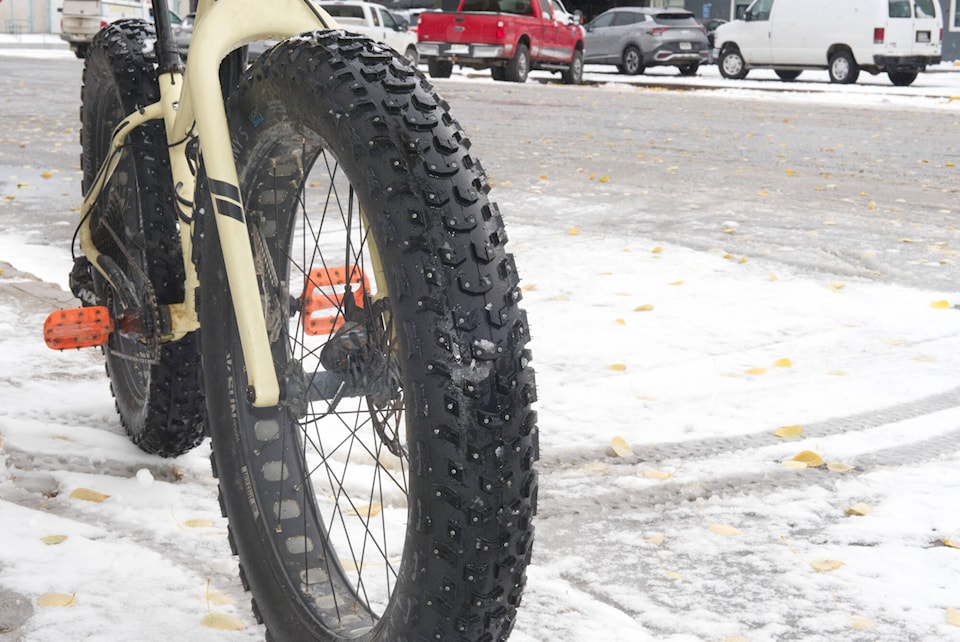Whitehorse has seen its first snowfall of the season and cyclists in the Yukon are bracing and making preparations for their commutes during the winter season.
Catherine Pinard, a Yukon resident who started biking during winter about 12 years ago when she lived in Kuujjuaq, Quebec, said winter cycling is a tricky and interesting experience. She said the bicycle she normally uses has studded tires. Studded tires provide traction on trails or on the road during icy or snowy weather conditions.
“I change my tires just like you do for your cars during the winter season,” she said.
She said fat bikes, which have studded tires, are usually recommended and ideal for biking during winter season because of the spikes, width and rough edges.
“Studded tires are good when the road is slippery or when there is ice or a little bit of snow,” she said.
But Pinard said she never uses fat bikes for commuting, but for fun rides during icy weather conditions.
“When I commute to work, especially when it’s longer distances, I just use my touring bike and put winter studded tires on it,” she said.
Whitehorse residents Julie DesBrisay and Daniel Jolkowski told the News that winter biking is fun and challenging.
“It’s cold and more dangerous because it’s dark,” DesBrisay said. “I am more careful, have studded tires and lots of light while biking.”
“I’ve been biking in the last five winters since I moved here,” said Jolkowski. “It’s more of a struggle biking during winter because the bikes are slower and the traffic on the road.”
Velonorth Cycling Club president Joel Macht said he bikes some during winter, but only when weather permits.
“Some people ride in their basements or stationary bike trails. The mountain bike trails are normally groomed ahead of the winter season for fat bikes to ride them,” he said. “It’s usually cold, so you need to have lots of layers and good tires. If they are not fat bikes, they should have studs on them.”
Macht said the Contagious Mountain Bike Club in Whitehorse takes care of the grooming and development of trails during winter in the city.
The club recommends using fat tires that are at least 3.8 inches wide, which helps in getting better traction.
The Cycling Association of Yukon provides some winter cycling tips focused on bike maintenance, using layered clothing, planning ahead, avoiding busy roads and wearing high-visibility vests or gear.
Dean Eyre, who runs Cadence Cycle in downtown Whitehorse, said the shop normally sees an increase in sales in studded tires, lights, winter helmets, warm weather gear and pogies (pockets placed on handlebars for hands, grips, brake levers, and shifters that act as a barrier to the weather) along with fat bikes this time of year.
Eyre said demand for fat bikes typically goes up during the winter season in Whitehorse.
During the colder months, Eyre said the shop receives rental requests for fat bikes because a lot of people who have not cycled during winter want to have that experience. For a full day, rentals for fat bikes go for $50 while a half day rental is $25.
“A lot of people come here for northern lights and they have to do something during the day. Quite a lot of them come here from Mexico and other places in South America during the winter time. Winter is something they have never experienced so it’s quite novel for them,” he said. “It’s a good time if you do have a bike to get major service work done because things take time and it’s a good time to do it during winter.”
As cycling during winter can be dangerous because of harsh weather conditions, Pinard said there are some areas to avoid.
“I don’t like biking along the Rabbit’s Foot Canyon,” she told the News of the area along the Alaska Highway near Porter Creek.
“That’s an area that is pretty narrow and high traffic, so I don’t love it there. If it’s possible, avoid that area,” she advised.
Pinard said when she wants to bike during winter, she normally leaves early in the morning, before rush hour, and also early in the afternoon or later once the rush hour periods are over.
“That’s what I did for many years, always trying to avoid the busy traffic times.”
Checking the weather conditions and forecasts are some of the ways of avoiding hazards while biking during winter, Pinard said.
“Some mornings, I would not take my bike if I knew there was going to be snow in the afternoon. If the conditions are difficult to drive in a car, then people may not see you or you’re forced to ride in the traffic lane. So, it’s good to be mindful of how motor vehicles will be reacting because of the weather.”
Contact Patrick Egwu at patrick.egwu@yukon-news.com
